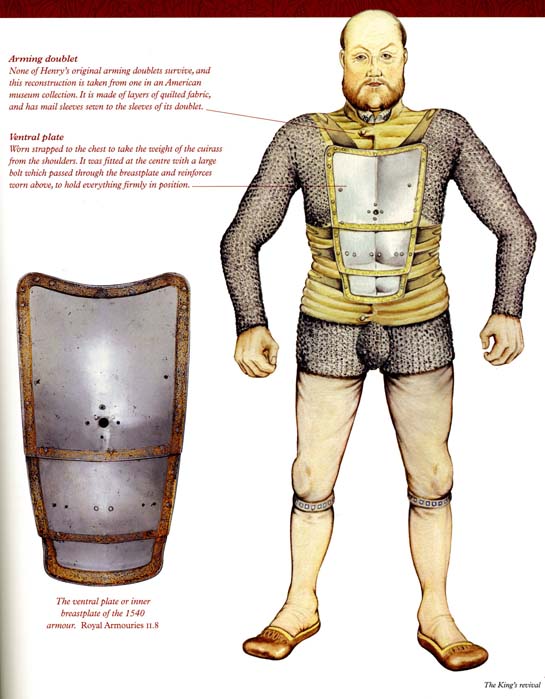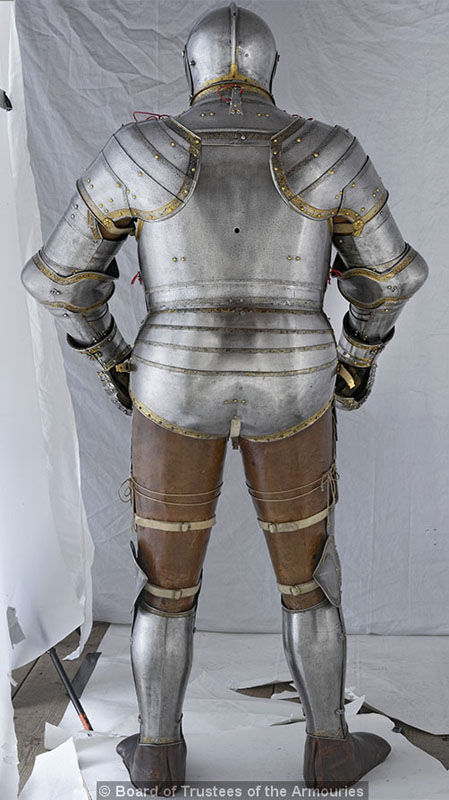Dear armour community,
I have read in certain sources, that the armour of Henry the VIII from 1540 has a certain ventral plate or inner breastplate. The sources state that the function of this device is the distribution of the weight of the breast an backplate and the arm protection on the entire upper body.
So far I could not find out anything about the appearance of this inner breastplate. Does anybody have a photo of the device or some additional information on how this ventral plate looks like?
Sources:
http://www.royalarmouries.org/line-of-kings/l...object/350
http://www.metmuseum.org/collections/search-the-collections/35775
http://www.metmuseum.org/collections/search-the-collections/35775
Also, any photo of the back of the 1540 armour of Henry VIII is very welcome.
[ Linked Image ]
Here's Henry VIII's armour from 1540. The only problem is I am not sure where the ventral part is.
Here's Henry VIII's armour from 1540. The only problem is I am not sure where the ventral part is.
They're scientific descriptors using Latin terms, dorsal (L. dorsum) is the backbone side while ventral (L. venter) is the belly side. In the case of humans, the ventral side is the front and dorsal is back, while on cattle ventral is down and dorsal is up.
Here's a picture of the plate and a drawing of its use from "The Armour & Arms of Henry VIII" by Thom Richardson.
 Attachment: 78.22 KB
Attachment: 78.22 KB


Thank you good sir! This was very helpful indeed!
| Chad Arnow wrote: |
| Here's a picture of the plate and a drawing of its use from "The Armour & Arms of Henry VIII" by Thom Richardson. |
Thanks, that's very helpful. Does this mean that Henry could have been wearing up to 3 pieces of steel over his chest?
It's very clever to distribute the weight to the hips like that. I wonder if it interfered with breathing at all to be strapped in around the ribs.
the fact that its a very rare bit of armour and never caught on leads me to think it wasn't worth having. We talked about replicating it once at the Tower as a handling object but decided there were much better items about than a souped up military tea tray.
It strikes me as being basically equivalent to wearing two bulletproof vests on top of each other-- if the external plates fail, you still have one behind those to protect your middle. A King is much less easily replaced than a few pieces of armour, especially one with such issues with succession as Henry 8th had... wonder if it was his idea or his counselors'?
As far as I know the main purpose of the ventral plate was not defence. If you look closely at the inner breastplate and the breastplate of the armour in question they both have a hole in the middle. As the sources state there was originally a rather large bolt that gone through both of these holes so the weight of the breast and back plate, the arm protection and the pauldrons was not carried by the shoulders but the waist. The whole inner breastplate functioned like a modern backpacking backpack. This sound very comfortable to me.
The piece was on display in the Tower about eight years ago. Here is a photo with a reconstruction from a slightly different angle than the picture already posted in the thread.
 Attachment: 85 KB
Attachment: 85 KB
[ Download ]
[ Download ]
I do not know if the sketch at the bottom of the picture is valid but it seems to me that the back plate also had a central bolt. Does anybody have a picture of the back of the armour?
Here you go, © Board of Trustees of the Armouries.
 Attachment: 105.2 KB
Attachment: 105.2 KB


| Quote: |
| The 1540 Armour of King Henry VIII
This armour is the greatest of the Greenwich garnitures made for King Henry VIII. It is possible that is was intended for wear at the tournament held during 1–5 May 1540 to celebrate May Day, which included tilts, tourneys and foot combats over the barriers. The two tournaments in January and May 1540 were the last Henry is known to have staged, but there is no record that he actually participated in them. No doubt his age (he was by this time 49) and his great bulk made this inappropriate. The armour is readily identifiable with the ‘Complete harness parcell grauen and gilte with all manner of peces of advantage for the felde Tilte Turney and fote’ at Greenwich in the 1547 inventory of the King’s goods. Not only does the armour have all the requisite extra pieces, but it has a double set of them. Also it has the second of only two known examples of a feature now unique to the Greenwich workshop. This is an inner breastplate or ventral plate strapped to the body and designed to lift the weight of the cuirass and arm defences from the shoulders by means of the central bolt to which the breastplate and plackart were secured. It is recorded that François I in 1520 disclosed this secret device to Henry, offering his armourers to make one for Henry if he sent one of his arming doublets for a pattern. The earlier example is on the ‘Genouilhac’ armour made for the King in 1527, and now in the Metropolitan Museum of Art, New York. Unfortunately the breastplate for the field, tilt and tourney of the 1540 armour is lost, and only that for the foot combat, which is not fitted for a lance rest, survives. The lance rest itself does survive. It is most likely that the armour had a reinforcing breastplate, like that of the ‘Genouilhac’ armour also, and a symmetrical right pauldron (without a cut-out for the lance) for use in the foot combat. The original foot defences, probably sabatons of plate, are also lost. |
Arrangements of garniture pieces, armour of Henry VIII. English, Greenwich, 1540.
[ Linked Image ]
http://media-cache-ak0.pinimg.com/originals/b...da6700.jpg
[ Linked Image ]
I do like the pinwheel on his left wrist, makes the whole harness look much more festive.
What puzzles me is the fact that the ventral plate was deemed necessary at all. A cuirass with a good arming garment underneath should already work quite well at distributing the weight of the entire harness between the shoulders and the hips. Could it have anything to do with Henry's expanding girth, which might have made it difficult to shape the armour so that it would partially rest on his hips rather than entirely on the shoulders? Or is it more about the heavier nature of 16th-century defences compared to their 15th century ancestors (as Gordon Frye experienced here)?
| Pat Kilbane wrote: |
| It's very clever to distribute the weight to the hips like that. I wonder if it interfered with breathing at all to be strapped in around the ribs. |
The "ventral plate" consists of three plates joined together by internal leathers. The whole assembly is capable of collapsing to some extent when the wearer bends forward. As such, it does not (and can not) place weight on the wearer's hips. That is to say, no more weight than that of the lowest plate of the assembly its self.
Mac
| Kertész Miklós József wrote: |
| I do not know if the sketch at the bottom of the picture is valid but it seems to me that the back plate also had a central bolt. Does anybody have a picture of the back of the armour? |
I had not noticed the hole in the backplate before. I wonder if this means that there was originally an internal "ventral plate" assembly as well.
The Genouillhac armor in the Met was built around a "ventral plate" as well. I will look at the monograph and see it it has a similar hole in the backplate.....
Mac
.... no. That armor has no hole in the backplate
Here's a link to a PDF of the monograph.
http://www.google.com/url?sa=t&rct=j&...9033,d.b2U
Mac
Here's a link to a PDF of the monograph.
http://www.google.com/url?sa=t&rct=j&...9033,d.b2U
Mac
I believe that the major benefit and purpose of the "ventral plate" is to provide an convenient anchor for the sholder straps of the backplate. In both of the surviving armors where it is employed, the gorget is external, and thus put on after the breast and back.
The arming sequence would be like this...
--strap on the "ventral plate" assembly.
--squeeze into the backplate
--strap the backplate to the "ventral plate" assembly.
--offer the breastplate up to the bolt on the "ventral plate" assembly.
--secure the breast with a nut.
--put on the gorget
--secure the gorget to the breast and back
The result is that the shoulder- weight of the armor is not on the gorget like you would expect, but rather on the internal shoulderstraps which run from the backplate to the "ventral plate" assembly.
All armor places some weight on the hips, and these armors are no exception. It is important to note that these armors have their waist lames attached with internal leathers which allow a certain amount of telescopic collapse. At most, the hips will carry the weight of the waist lames and the skirts.
On the grand scale of things, I think we have to conclude that the whole "ventral plate" thing was not worth the fuss. They were only ever made at Greenwich, and then only for a few years. Henry VIII must have liked them OK, but then again he liked high tech military toys. The gun-shields did not exactly catch on either. ;)
Mac
The arming sequence would be like this...
--strap on the "ventral plate" assembly.
--squeeze into the backplate
--strap the backplate to the "ventral plate" assembly.
--offer the breastplate up to the bolt on the "ventral plate" assembly.
--secure the breast with a nut.
--put on the gorget
--secure the gorget to the breast and back
The result is that the shoulder- weight of the armor is not on the gorget like you would expect, but rather on the internal shoulderstraps which run from the backplate to the "ventral plate" assembly.
All armor places some weight on the hips, and these armors are no exception. It is important to note that these armors have their waist lames attached with internal leathers which allow a certain amount of telescopic collapse. At most, the hips will carry the weight of the waist lames and the skirts.
On the grand scale of things, I think we have to conclude that the whole "ventral plate" thing was not worth the fuss. They were only ever made at Greenwich, and then only for a few years. Henry VIII must have liked them OK, but then again he liked high tech military toys. The gun-shields did not exactly catch on either. ;)
Mac
Page 1 of 2
You cannot post new topics in this forumYou cannot reply to topics in this forum
You cannot edit your posts in this forum
You cannot delete your posts in this forum
You cannot vote in polls in this forum
You cannot attach files in this forum
You can download files in this forum
All contents © Copyright 2003-2006 myArmoury.com — All rights reserved
Discussion forums powered by phpBB © The phpBB Group
Switch to the Full-featured Version of the forum
Discussion forums powered by phpBB © The phpBB Group
Switch to the Full-featured Version of the forum